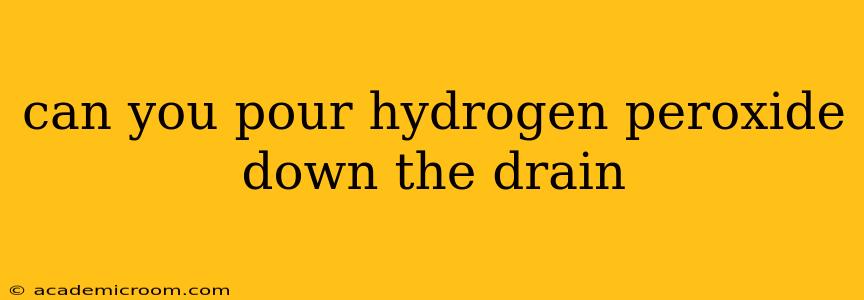Can You Pour Hydrogen Peroxide Down the Drain? A Comprehensive Guide
Hydrogen peroxide is a common household item used for cleaning and disinfecting. But what happens when you're finished with it? Can you simply pour it down the drain? The answer isn't a simple yes or no, and depends on several factors. This guide will explore the safety and environmental implications of disposing of hydrogen peroxide, addressing common questions and concerns.
Is it harmful to pour hydrogen peroxide down the drain?
The short answer is: it depends on the concentration. Low concentrations of hydrogen peroxide (3% solutions, like those found in drugstores) generally break down quickly into water and oxygen. This means small amounts pose minimal risk to your plumbing or the environment. However, higher concentrations (e.g., 30% or higher) can be corrosive and harmful to pipes and septic systems. They can also damage beneficial bacteria in wastewater treatment plants.
What happens when you pour hydrogen peroxide down the drain?
When diluted hydrogen peroxide goes down the drain, it undergoes a process called decomposition. This is a natural reaction where the hydrogen peroxide breaks down into water (H₂O) and oxygen (O₂). The oxygen is released harmlessly into the atmosphere. This process is accelerated in the presence of catalysts like certain metals.
What concentration of hydrogen peroxide is safe to pour down the drain?
As a general rule, only low concentrations (3%) of hydrogen peroxide should be poured down the drain. Always check the label to confirm the concentration. For higher concentrations, it's essential to seek alternative disposal methods.
What are the environmental concerns of pouring hydrogen peroxide down the drain?
While low concentrations pose minimal environmental risk, large quantities of even diluted hydrogen peroxide can still impact aquatic life if they reach waterways untreated. High concentrations are definitely harmful. Therefore, responsible disposal is crucial to minimizing environmental impact.
What are the best ways to dispose of hydrogen peroxide?
- Low concentrations (3%): Dilute with plenty of water and pour down the drain.
- Higher concentrations: Contact your local waste management authority for guidance. They can provide information on appropriate disposal methods, possibly including hazardous waste collection centers. Never mix hydrogen peroxide with other cleaning products, as this can create dangerous reactions.
- Large quantities: Regardless of concentration, large quantities should be handled carefully and disposed of according to local regulations.
Can hydrogen peroxide damage my pipes?
Highly concentrated hydrogen peroxide can be corrosive to certain materials commonly used in plumbing systems. While low concentrations are generally safe, it's always best to err on the side of caution and dilute thoroughly before disposal.
What should I do if I accidentally pour a high concentration of hydrogen peroxide down the drain?
Flush the drain with plenty of water. If you notice any unusual reactions or damage to your pipes, contact a plumber immediately. Also, contact your local waste management authority to report the incident.
In conclusion, while small amounts of low-concentration hydrogen peroxide are generally safe to pour down the drain, it's crucial to be mindful of the concentration and always prioritize responsible disposal practices. For higher concentrations or larger volumes, contact your local waste management authority for the safest and most environmentally sound disposal method. By following these guidelines, you can help protect your plumbing, the environment, and your safety.
